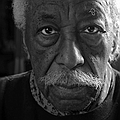Visual indexes for this photographer are available for subscribers.There is so much more to explore when you subscribe. Subscriptions
Gordon Parks Parks decided to be a photographer in 1937 after he saw a film depicting the sinking of the U.S.S. Panay in China. At this time, he was working as a waiter for the Northern Pacific Railroad. Parks went back to Seattle and promptly bought his first camera, and the Kodak shop which developed his film gave him his first show. He was fired from Northern Pacific after getting into an altercation with a white man, but soon got his first professional job working as a fashion photographer for a store by the name of Murphy's in St. Paul, Minnesota (Bush, 9-14). Photographing the models at Murphy's marked the start of Parks' experience working in the fashion industry. In 1941 Parks won a Julius Rosenwald fellowship for his photographic work at Chicago's South Side Community Art Center. In the same year he chose to work for Roy Stryker at the Farm Security Administration. It was there he “learned how to fight the evil of poverty – along with the evil of racism – with a camera” (Bush, 38). One of his first and most well known pictures he took in the nation's capital was “American Gothic,” 1942. The subject of the photo, framed by a mop, a broom, and the American flag, was a charwoman by the name of Ella Watson, also working at the FSA. Watson had lived a rough and tragic life marred by violent racism and poverty. After hearing her story, it was Parks who posed her and sought to compose a narrative of her experience through the use of his camera (Brookman, 33 ; 348-349). In accordance with the FSA's mission, he traveled through various parts of the U.S., recording the Depression's impact on culture and society. By 1943, the FSA was disbanded. Both Parks and Stryker were transferred to the Office of War Information (OWI). Parks was scheduled to accompany black troops overseas, but the assignment was abruptly cancelled. It was said that an unnamed politician from the South did not want too much publicity for black soldiers. Stryker and Parks soon moved on to the Standard Oil Company, which sponsored a large photo documentary project. Though it was designed to combat the company's infamous reputation for discriminatory policies, the program was not a huge success for Standard Oil . Ironically, Parks was still subjected to anti-black sentiment (Bush, 49-50; 56). He was eventually laid off by his longtime mentor and employer, Roy Stryker. Parks had never forgotten his interest and talent in fashion photography. Alexey Brodovitch at Harper's Bazaar admired his fashion pictures, and promptly said that due to being a William Randolph Hearst publication, they could not hire any black staff members. Nevertheless, Parks went on to freelance for Vogue and Glamour, and established his reputation as a superior fashion photographer (Brookman, 76). This experience served him well when LIFE assigned him to cover the French collections in Paris, despite the fact he had been with the magazine for only eighteen months (Bush, 99). Along with major fashion contributions, Parks photographed dozens of noteworthy people for LIFE; among them were Ingrid Bergman, Dwight Eisenhower, Winston Churchill, Grace Kelley, Louis Armstrong, Paul Newman, and Muhammad Ali. Parks' extraordinary documentary work chronicled poverty, crime, school segregation, Communist demonstrations, the return of U.S. Korean War veterans, the Civil Rights movement, and the Black Panthers. During his tenure at Life , Parks covered everything from the latest fashions in women's garters to prison riots in New Jersey (Bush, 128-134). In 1969, Parks directed his first film, The Learning Tree. Four additional films followed: Shaft (1971), Shaft's Big Score (1972), The Super Cops (1974), and Leadbelly (1976) (Bush, 127). During this time, from 1970-1973, the man who had become known as “The Poet and His Camera” was the editorial director for Essence magazine (Auer). During his entire career and throughout the last decade of his life, Parks continued to write, paint, compose, and photograph. Looking back on his success, he recalled a white schoolteacher who instructed him and his classmates not to bother with college, since they would all end up as “porters and maids” anyway. Though he was grateful to have proven her wrong, he acknowledged that he never made peace with the memories of his birthplace. Parks impatiently waited “for that segregated graveyard to become a forgotten memory” (Brookman, 343). References Photographers Encyclopedia International: 1839 to the Present, L-Z. Michèle and Michel Auer. 1985. Editions Camera Obscura. The Photographs of Gordon Parks. Martin H. Bush. 1983. Wichita State University. Gordon Parks: Half Past Autumn: A Retrospective. Philip Brookman. 1997. Bulfinch Press, Little, Brown and Co. Roy Stryker: USA 1943-1950. Steven W. Plattner and Cornell Capa. 1983. University of Texas Press. LIFE Photographers: Their Careers and Favorite Pictures. Stanley Rayfield. 1957. Doubleday and Co. [Contributed by Erin McGrath - Lee Gallery]
|

